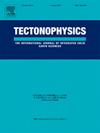新扎-定野裂谷南部大地震的复发与2025年1月7日藏南定日Mw7.1级地震的比较
IF 2.6
3区 地球科学
Q2 GEOCHEMISTRY & GEOPHYSICS
引用次数: 0
摘要
西藏南部被7个ns走向的裂谷所分割,这些裂谷被正断层所包围,这些正断层吸收了约9毫米/年的东西向伸展,超过约1000公里。虽然这个偏远地区很少发生大地震,但2025年1月7日发生的Mw7.1级廷日地震发生在一个已知长期抛断率的断层上,为比较同震变形和长期断层行为提供了一个很好的机会。本文首次报道了新扎-定野裂谷南段定木木断裂带(同震垂直偏移0.9 m)和拉古断裂带的地震后主要野外观测结果。然后,我们将这些观测结果与根据10Be地表暴露测年和累积偏移量的地形测量结果得出的丁木木断裂带晚第四纪的断距和伸展率进行比较。结果表明,在过去的19±5 ka中,投掷率和延伸率分别为1.1(+0.5/−0.2)和1.1±0.3 mm/yr。这表明这条相对较短的断层起了重要作用,约占藏南东西向伸展的12%。这些发现表明,丁木木断裂带上类似震级的地震平均复发间隔为~ 800年。本文章由计算机程序翻译,如有差异,请以英文原文为准。
Recurrence of large earthquakes along the southern Xainza-Dinggye rift and comparison with the 7 January 2025, Mw7.1 Tingri earthquake, southern Tibet
Southern Tibet is dissected by seven NS-trending rifts bounded by normal faults absorbing ∼9 mm/yr of EW extension over ∼1000 km. While large earthquakes are rare in this remote region, the occurrence of the 7 January 2025, Mw7.1 Tingri earthquake on a fault with a known long-term throw rate, presents a great opportunity to compare co-seismic deformation with long-term fault behavior. Here, we first report our main post-earthquake field observations along the seismogenic Dingmuco fault (0.9 m of co-seismic vertical offset) and Lagoi fault within the southern Xainza-Dinggye rift. We then compare these observations with late Quaternary throw and extension rates along the Dingmuco fault, derived from 10Be surface-exposure dating and topographic measurements of cumulative offsets. Our results yield throw rate and extension rates of 1.1(+0.5/−0.2) and 1.1 ± 0.3 mm/yr, respectively, over the past 19 ± 5 ka. This suggests that this relatively short fault plays a substantial role, accommodating roughly 12 % of the total EW extension across southern Tibet. These findings imply an average recurrence interval of ∼800 years for earthquakes of similar magnitude along the Dingmuco fault.
求助全文
通过发布文献求助,成功后即可免费获取论文全文。
去求助
来源期刊

Tectonophysics
地学-地球化学与地球物理
CiteScore
4.90
自引率
6.90%
发文量
300
审稿时长
6 months
期刊介绍:
The prime focus of Tectonophysics will be high-impact original research and reviews in the fields of kinematics, structure, composition, and dynamics of the solid arth at all scales. Tectonophysics particularly encourages submission of papers based on the integration of a multitude of geophysical, geological, geochemical, geodynamic, and geotectonic methods
 求助内容:
求助内容: 应助结果提醒方式:
应助结果提醒方式:


